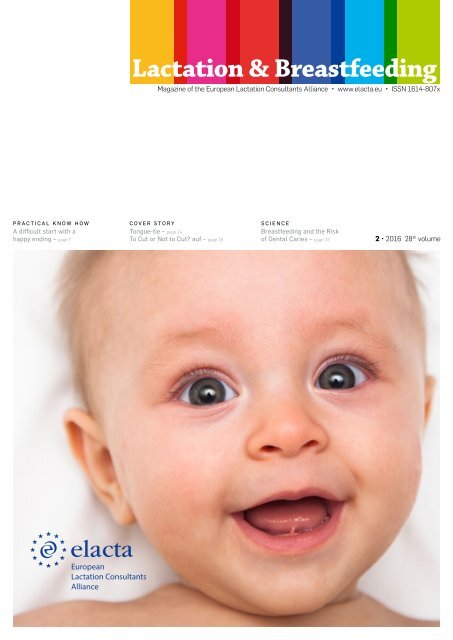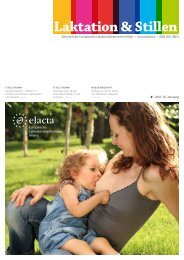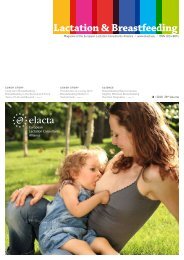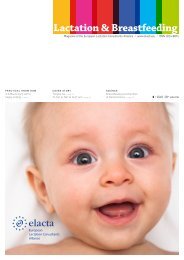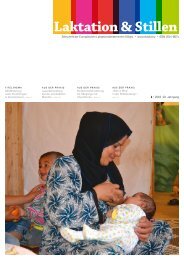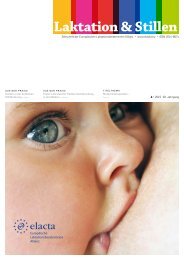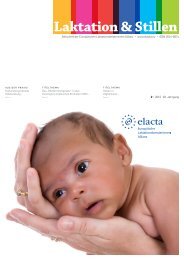Laktation_und_Stillen_2016-2 EN p1-8 web
Create successful ePaper yourself
Turn your PDF publications into a flip-book with our unique Google optimized e-Paper software.
Lactation & Breastfeeding<br />
Magazine of the European Lactation Consultants Alliance • www.elacta.eu • ISSN 1614-807x<br />
PRACTICAL KNOW HOW<br />
A difficult start with a<br />
happy ending – page 7<br />
COVER STORY<br />
Tongue-tie – page 14<br />
To Cut or Not to Cut? auf – page 18<br />
SCI<strong>EN</strong>CE<br />
Breastfeeding and the Risk<br />
of Dental Caries – page 23<br />
2 • <strong>2016</strong> 28 th volume
2<br />
EDITORIAL<br />
EDITORIAL<br />
Dear colleagues, dear readers,<br />
The magazine production takes time. In most cases the production of the next<br />
issue starts long before the previous issue appeared. At the time that you<br />
receive this magazine, ELACTA Conference has already taken place and ELACTA<br />
will already have a new board and a new president. The detailed information on<br />
the general assembly, the new board and the new president will be part of the<br />
issue 3/16.<br />
Thus this is going to be my last editorial for Lactation & Breastfeeding. Although<br />
I will carry on being a part of the editorial team, it is about time to step<br />
down as president and to thank all, who enriched our work for ELACTA in the<br />
last two years and before that. Great thanks to my six board colleagues (Karin,<br />
Juanita, Mirjam, Heli, Renata and Maja), to the members of the national associations<br />
and especially to their presidents (we recently also have a male president),<br />
to the editorial team, that invests its talent and heart in producing Lactation &<br />
Breastfeeding, to those colleagues I have had the chance to get to know during the<br />
preparations for the Conference in Athens, etc., etc...<br />
I am grateful for moving encounters with you, all this new knowledge, for getting<br />
an insight into the work of IBCLCs and the situation of the supported families<br />
all over Europe. We built up new networks and established new friendships.<br />
By now, ELACTA comprises 21 IBCLC national associations from all over Europe.<br />
Furthermore, IBCLCs work in a wide range of occupational fields. During<br />
the Conference in Athens we were able to gather an interesting mixture of experiences,<br />
knowledge, and approaches to various issues in breastfeeding consultation.<br />
Even this issue of Lactation & Breastfeeding demonstrates the various ways to<br />
find a solution to a particular problem – in this case regarding the tongue frenulum.<br />
Dr. Daniela Karall, IBCLC, Austria, and Márta Guóth-Gumberger, IBCLC,<br />
Germany, introduce us to diagnosis and treatment, in particular the surgical treatment<br />
of the tongue frenulum. Myrte van Lonkhuijsen, IBCLC, the Netherlands,<br />
identifies more practical ways of how IBCLCs can manage breastfeeding problems<br />
caused by the tongue frenulum. And finally a mother reports on her own painful<br />
breastfeeding experience and the difficult journey of finding appropriate treatment.<br />
Matching the issue “oral health”, Dr. Zsuzsa Bauer provides us with an update<br />
on the scientific evidence regarding breastfeeding and oral caries.<br />
Breastfeeding support for refugees remains an issue as well; the moving interview<br />
of Martina Tomić Latinac speaks for itself. Let us hope that those reports will<br />
soon be considered as nothing more than having historical value.<br />
Enjoy your reading! The team is always happy to receive reader’s letters, articles,<br />
and reports from our member countries.<br />
Yours sincerely,<br />
Andrea Hemmelmayr, IBCLC<br />
IMPRINT<br />
Herausgeber:Company<br />
Information:<br />
ELACTA European Lactation<br />
Consultants Alliance<br />
www.elacta.eu<br />
Email: magazin@elacta.eu<br />
ZVR-Nr.: 708420941<br />
ELACTA president:<br />
Karin Tiktak, IBCLC<br />
president@elacta.eu<br />
Editorial and project<br />
coordination:<br />
Eva Bogensperger-Hezel, IBCLC<br />
Email: magazin@elacta.eu<br />
Team:<br />
Andrea Hemmelmayr, IBCLC<br />
Stefanie Frank, IBCLC<br />
Elke Cramer, Ärztin, IBCLC<br />
Kathrin Meier, IBCLC<br />
Bärbel Waldura, IBCLC<br />
Zsuzsa Bauer, Dr. phil<br />
Márta Gúoth-Gumberger, IBCLC<br />
Gudrun von der Ohe, Ärztin,<br />
IBCLC<br />
Translations:<br />
Márta Gúoth Gumberger, IBCLC<br />
Elizabeth Hormann, IBCLC<br />
Annika Cramer, Martina Hezel,<br />
Vera Bogensperger<br />
Einzelabonnements:<br />
E-Mail: abobestellung@elacta.eu<br />
Jahresabonnement: 41 €<br />
Einzelnummer: 12 €<br />
Photos: © as mentioned on the<br />
photos; Coverphoto: iStock<br />
Layout: Christoph Rossmeissl<br />
Production: EinDRUCK<br />
Edition: 2.500<br />
Published quaterly at the end<br />
of March, June, September and<br />
December<br />
Deadline: 15 January, 15 April,<br />
15 July, 15 October<br />
Dear readers! We want to know<br />
what you think. Please send your<br />
letters and comments to the<br />
following email address:<br />
magazin@elacta.eu<br />
www.elacta.eu Lactation & Breastfeeding 2 • <strong>2016</strong>
CONT<strong>EN</strong>TS<br />
3<br />
2 EDITORIAL<br />
4 LETTER TO THE EDITOR<br />
5 HANDOUT<br />
7 PRACTICAL KNOW HOW<br />
A Difficult Start With a Happy Ending<br />
Breastfeeding Support for Syrian Refugee<br />
Mothers in Croatia<br />
The Consequences of Not Breastfeeding in<br />
the Refugee Camp in Croatia<br />
13 WITHOUT WORDS<br />
14 COVER STORY<br />
Tongue-tie<br />
To Cut or Not to Cut?<br />
20 ELACTA NEWS<br />
The 9 th Lactation and Breastfeeding<br />
Congress in Athens is Now History<br />
21 BOOK REVIEW<br />
Breastfeeding<br />
The Rabbit Who Wants to Fall Asleep<br />
23 SCI<strong>EN</strong>CE<br />
Breastfeeding and the Risk of Dental Caries
4<br />
LETTER TO THE EDITOR<br />
Nipple Shields and reduced breastfeeding duration –<br />
is there a causal association?<br />
Letter to the editor: Does the Use of Nipple Shields Influence Breastfeeding Duration?<br />
With respect to the analysis of<br />
the data “Infant Nutrition Today,<br />
2006” regarding the use of nipple<br />
shields (<strong>Laktation</strong> & <strong>Stillen</strong>, 2015/4,<br />
pp. 20 – 24) and to the letter of Dr.<br />
phil. Zsuzsa Bauer (<strong>Laktation</strong> & <strong>Stillen</strong>,<br />
<strong>2016</strong>/1, p. 4) replying to the aforementioned<br />
article, I would like to add something<br />
to the topic:<br />
Many thanks to Mrs. Bauer for indicating<br />
the causal relationship and for her respectful<br />
and professional analysis of the study<br />
design. Her perfectly competent explanations<br />
confirmed me in my judgement.<br />
For several weeks now, the article lies<br />
on my desk and in the course of a comprehensive<br />
analysis of scientific work, I kept it<br />
at hand for reference and analysis. It elicited<br />
many content-related as well as formal<br />
discussions with colleagues in daily clinical<br />
practice.<br />
Every professional IBCLC must critically<br />
scrutinise their indication for the use of<br />
nipple shields and know about the consequences.<br />
This goes without saying.<br />
However, in the whole context of the<br />
usage and the controversial debate on pros<br />
and cons of nipple shields, one quite crucial<br />
factor is given insufficient attention:<br />
i.e. using a nipple shield restores self-efficacy<br />
to the mother-child dyad since breastfeeding<br />
would not be possible without<br />
the nipple shields. I work as an IBCLC at<br />
a “Baby-friendly Hospital” in Switzerland<br />
with more than 1000 deliveries a year and I<br />
frequently observe the in my opinion false<br />
ambition of weaning mother and child<br />
22<br />
SCI<strong>EN</strong>CE<br />
Does the Use of Nipple Shields Influence<br />
Breastfeeding Duration?<br />
Analysis of the Austrian study “Infant Feeding Today, 2006” Dr. Beate Pietschnig for “Österreichische Stillkommission des<br />
Obersten Sanitätsrates”, (2004–2010); translation: Elizabeth Hormann, IBCLC<br />
ABSTRACT:<br />
Backgro<strong>und</strong><br />
Nipple shields are frequently recommended<br />
at the beginning of breastfeeding<br />
to help mothers with sore nipples<br />
and with nipples with anomalies.<br />
Nipple shields are intended to enable<br />
mothers to breastfeed, although the<br />
data is very contradictory. The goal of<br />
the study was to examine the effects<br />
of nipple shields on breastfeeding<br />
duration.<br />
Material and Methods<br />
Data on the use of nipple shields in<br />
correlation to breastfeeding duration<br />
and the infant´s weight gain was collected<br />
and analyzed in the context<br />
of the study “Infant Feeding Today –<br />
2006”<br />
719 mothers of 728 children from all<br />
over Austria were qinterviewed three,<br />
six and 12 months after birth. 25 % of<br />
the 719 mothers were given a nipple<br />
shield postpartum, 52.7 % of them due<br />
to painful nipples.<br />
Results<br />
Infants who were breastfed with nipple<br />
shields at the beginning showed significantly<br />
shorter times of exclusive and<br />
partial breastfeeding. The weight gain<br />
patterns of the children did not show<br />
any significant differences.<br />
Conclusion<br />
The results show that nipple shields<br />
negatively influence the duration of<br />
breastfeeding. Thus, the uncriticial and<br />
unsupported use of nipple shields is<br />
not recommended.<br />
Keywords:<br />
› breastfeeding<br />
› breastfeeding counselling<br />
› nipple shields<br />
› breastfeeding duration<br />
xclusive breastfeeding for approximately<br />
the first six months of the<br />
E<br />
infant’s life is nationally and internationally<br />
recommended. 1, 5, 8, 9, 22 , as<br />
breastfeeding is amongst the most effective<br />
health-promoting measures in<br />
the health care system 3<br />
The use of nipple shields is recommended<br />
for treatment or prevention of<br />
pain and sore nipples and to ease attachment.<br />
Especially in anatomical variations<br />
(such as inverted or flat nipples) , nipple<br />
shields can enable breastfeeding at all On<br />
the other hand, nipple shields can lead to<br />
breastfeeding problems.<br />
Breastfeeding counsellors report that<br />
mothers are often given nipple shields in<br />
the first few days in hospital unreflected<br />
and without detailed information. In the<br />
related literature, there is little and very<br />
contradictory information on the benefits<br />
and risks of nipple shields. Although<br />
there are absolute (inverted nipples) and<br />
relative indications (i.e. flat nipples and,<br />
sometimes, premature babies) for the use<br />
of nipple shields, practice shows that nipple<br />
shields are also often recommended<br />
without specific indications. Consequences<br />
of the (unreflected) use of nipple shields include<br />
earlier supplementation and weaning<br />
of the baby.<br />
To evaluatethe outcome of early niplle<br />
shield use, the survey “Infant feeding Today<br />
2006”, was conducted to evaluate the<br />
use of nipple shields in the initial days of<br />
life. The survey was conducted on behalf<br />
of the Austrian Federal Ministry of Health<br />
and the Austrian Breastfeeding Committee,<br />
Methods<br />
In the Austrian study, “Infant Feeding<br />
2006”, two topics were evaluated : the<br />
structure of in – hospital care in the ob-<br />
www.elacta.eu Lactation & Breastfeeding 4 • 2015<br />
from the nipple shields, however well-intentioned,<br />
although breastfeeding management<br />
works well.<br />
While it is true that we as lactation<br />
consultants during puerperium or as freelancer<br />
midwives (after birth) can support<br />
mother and child to establish a good latch,<br />
but what happens if they at home or elsewhere<br />
fail to latch without our professional<br />
support? Some might argue that it must be<br />
dealt with correctly from the start, and this<br />
is perfectly justifiable. However, in daily<br />
routine the reality is somewhat different.<br />
And everyone who cares for mother and<br />
child over several days in every shift according<br />
to primary nursing concept in a<br />
hospital with 24-hour operation (and not<br />
merely during a one-to-one consultation)<br />
knows the situation of not reaching the<br />
aim without the use of nipple shields despite<br />
all efforts and interventions: The aim<br />
is to support mother and child to develop a<br />
successful breastfeeding relationship. That<br />
is why I would not advocate a positive ethics<br />
committee vote regarding experimental<br />
studies involving the impact of nipple<br />
shields on breastfeeding duration, since it<br />
would involve depriving mother-child dyads<br />
of a useful intervention.<br />
In my daily routine as a breastfeeding<br />
consultant, women suffering from breast<br />
engorgement or mastitis attend my outpatient<br />
counselling service because in aftercare<br />
too little attention is paid to the new<br />
situation of being at home. In my personal<br />
experience, the use of nipple shields has a<br />
rehabilitative character, due to the principle:<br />
“Help me do it myself!”<br />
With respect to the debate on nipple<br />
shields, reference is made to a review that<br />
was published in October 2015: “The use<br />
of nipple shields: a review”; Chow et al.;<br />
doi:10.3389/fpubh.2015.00236.<br />
This review was conducted to evaluate<br />
the evidence and outcomes that are associated<br />
with the use of nipple shields.<br />
Claudia Wronski El Awamry<br />
Registered nurse<br />
IBCLC at the “Baby-friendly Hospital”<br />
Limmattal, Switzerland.<br />
www.elacta.eu Lactation & Breastfeeding 2 • <strong>2016</strong>
Source: www.elacta.eu/en/downloads.html<br />
HANDOUT<br />
Baby-led Weaning<br />
Baby-led weaning is a common-sense, easy and<br />
enjoyable way to help your baby move on to family<br />
meals<br />
www.elacta.eu<br />
What is baby-led weaning?<br />
Baby-led weaning is a way of introducing<br />
solid foods that allows babies to<br />
feed themselves – there’s no need for<br />
spoon feeding or purées. The baby sits<br />
with the family at mealtimes and joins<br />
in when he is ready, feeding himself first<br />
with his fingers and later with cutlery.<br />
Baby-led weaning:<br />
› allows babies to explore taste, texture,<br />
colour and smell<br />
› encourages independence and confidence<br />
› helps to develop their hand-eye coordination<br />
and chewing skills<br />
› makes picky eating and mealtime<br />
battles less likely<br />
All healthy babies can begin to feed<br />
themselves from about six months.<br />
They just need to be given the opportunity.<br />
Why baby-led weaning makes<br />
sense<br />
Baby-led weaning is based on the way<br />
babies develop in their first year.<br />
Babies’ immune and digestive systems<br />
aren’t ready for other foods until they<br />
are about six months old – breast milk<br />
(or infant formula) is all healthy babies<br />
need until then.<br />
In the past, when babies were started<br />
on solid foods at three or four months,<br />
they had to be spoon fed with purées.<br />
At six months, most babies are able to<br />
sit upright, pick up pieces of food, take<br />
them to their mouth and chew them –<br />
in other words, they can feed themselves.<br />
If you’ve waited until your baby is six<br />
months to introduce solid foods you’ve<br />
skipped the purée stage, so there’s no<br />
need to start that way.<br />
How do we get started?<br />
› Sit your baby upright, facing the<br />
table, either on your lap or in a high<br />
chair. Make sure she is able to sit<br />
steadily and can use her hands and<br />
arms freely.<br />
› Offer your baby food, rather<br />
than give it to her – put it in front<br />
of her, or let her take it from your<br />
hand, so that the decision is hers.<br />
› Start with foods that are easy to<br />
pick up – thick sticks or long strips<br />
are best at first. Introduce new<br />
shapes and textures gradually so<br />
that your baby can work out how to<br />
handle them.<br />
› Include your baby in your mealtimes<br />
whenever you can. As far as<br />
possible – as long as it’s suitable –<br />
offer her the same food as you are<br />
eating, so that she can copy you.<br />
› Choose times when your baby is<br />
not tired or hungry, so she can<br />
concentrate. Mealtimes at this stage<br />
are for play and learning – she will<br />
still be getting all her nourishment<br />
from her milk feeds.<br />
› Carry on offering breast or formula<br />
feeds as before – this is still your<br />
baby’s main source of nutrition until<br />
she is a year old. When she needs<br />
less she will reduce her milk feeds<br />
herself.<br />
› Offer your baby water with her<br />
meals so she can drink if she needs<br />
to. If she chooses not to, that means<br />
she doesn’t need to.<br />
› Don’t hurry your baby or distract<br />
her while she is handling food – allow<br />
her to concentrate and take her<br />
time.<br />
› Don’t put food into your baby’s<br />
mouth for her or try to persuade<br />
her to eat more than she wants.<br />
Photos: © Katja König
HANDOUT<br />
Which foods can I offer my baby?<br />
You can share most healthy family<br />
foods with your baby. For example,<br />
fruit, cooked vegetables, meat, cheese,<br />
well-cooked eggs, bread (or toast), rice,<br />
pasta, and most fish are suitable. Start<br />
with foods that are easy to cut into<br />
sticks or large strips.<br />
Offering your baby a variety of foods<br />
will give him the chance to discover different<br />
tastes and textures and ensure he<br />
gets all the nutrients he needs.<br />
Foods to avoid<br />
› Added salt and sugar (read labels<br />
carefully – many foods, such as<br />
baked beans, pies, sauces and gravy,<br />
contain a lot of salt)<br />
› “Fast foods” and ready meals<br />
› Honey, shellfish, shark, marlin and<br />
<strong>und</strong>er-cooked eggs<br />
Tips<br />
› Don’t expect your baby to eat much<br />
at first. Many babies eat only small<br />
amounts for the first few months<br />
of baby-led weaning. For your baby<br />
these early mealtimes are about<br />
discovering and learning rather than<br />
eating.<br />
› Expect some mess! Spread a clean<br />
mat <strong>und</strong>er your baby’s chair to protect<br />
the floor – and so you can hand<br />
dropped pieces back to him.<br />
› Keep it enjoyable. That way your<br />
baby will be keen to try new foods<br />
and look forward to mealtimes.<br />
Won’t he choke?<br />
Even when weaning was recommended<br />
from four months, parents were encouraged<br />
to introduce finger foods at<br />
aro<strong>und</strong> six months to help their baby<br />
BEFORE<br />
AFTER<br />
Note that in the beginning the baby only eats small amounts of the offered food.<br />
develop his chewing skills – the difference<br />
with baby-led weaning is that<br />
there’s no spoon feeding alongside the<br />
finger foods. So, provided basic safety<br />
rules are observed, choking is no more<br />
likely with baby-led weaning than with<br />
the conventional method of introducing<br />
solids. In fact, allowing babies to<br />
control what goes into their mouths<br />
may actually help them learn to eat<br />
safely.<br />
Keep your baby safe<br />
› Make sure your baby is sitting upright<br />
to eat.<br />
› Avoid nuts, whole or in pieces.<br />
› Cut small fruits such as olives and<br />
cherries in half; remove any stones.<br />
› Don’t let anyone except your baby<br />
put food into his mouth.<br />
› Explain how baby-led weaning works<br />
to anyone caring for your baby.<br />
› NEVER leave your baby alone with<br />
food.<br />
Photos: © A. Cramer<br />
Note<br />
If you have a family history of food<br />
intolerance, allergies or digestive problems,<br />
or any other concerns about your<br />
baby’s health or development, you may<br />
wish to discuss the introduction of solids<br />
with your health advisers.<br />
The “Baby-led” series of books,<br />
by Gill Rapley and Tracey Murkett,<br />
includes Baby-led Weaning,<br />
Helping your baby to love good<br />
food, The Baby-led Weaning<br />
Cookbook, Baby-led Breastfeeding<br />
and Baby-led Parenting.<br />
For more information see www.<br />
baby-led.com and www.rapleyweaning.com<br />
IBCLC<br />
International Board Certified Lactation<br />
Consultants are the only internationally<br />
approved breastfeeding and lactation<br />
specialists having a medical backgro<strong>und</strong>.<br />
The decision to breastfeed or not to<br />
breastfeed has short- and long-term<br />
impact on the health of child and mother.<br />
However, breastfeeding sometimes turns<br />
out to be difficult and perhaps professional,<br />
competent assistance is needed.<br />
Contact your IBCLC<br />
www.elacta.eu Lactation & Breastfeeding 2 • <strong>2016</strong>
PRACTICAL KNOW HOW<br />
7<br />
A Difficult Start With a<br />
Happy Ending<br />
Posterior tongue-tie – an unfamiliar barrier to breastfeeding Author: MD. A. Dittmar<br />
During my entire pregnancy, I had never<br />
worried about possible problems<br />
with breastfeeding. I was certain that it<br />
would work. Unfortunately however, right<br />
from the start, my daughter had problems<br />
sucking at the breast. The nipple always<br />
“slipped” out of her mouth. Even in the<br />
delivery room, after the first breastfeed, an<br />
experienced midwife told me that my nipple<br />
was “too big” and my daughter would<br />
not be able to feed from it. She advised me<br />
to use a nipple former before putting her<br />
to breast. But the feeding problems continued<br />
over her first few days of life. After<br />
being put to breast, my daughter sucked a<br />
few times, but always let the nipple slide<br />
out of her mouth quickly again. I had the<br />
feeling that she couldn’t grasp the nipple<br />
correctly. Moreover, my daughter always<br />
fell asleep after a short time on the breast.<br />
In the hospital (a maximum care center) I<br />
felt that I was being poorly advised about<br />
this and left totally alone. The only person<br />
who really dealt with me and my breastfeeding<br />
problems was a night nurse who always<br />
had new ideas and suggestions about<br />
how feeding could be improved. After three<br />
days, I was advised to supplement, since<br />
my daughter was losing a lot of weight and<br />
there was no sign of any tendency towards<br />
improvement. But very quickly, there was<br />
more than enough milk.<br />
My postpartum midwife – also very<br />
experienced and wonderful – decided to<br />
try putting her to breast at home with a<br />
nipple shield, - which functioned better.<br />
Nevertheless, I had to pump and feed her<br />
the expressed milk with the bottle because<br />
feeding at the breast alone was insufficient.<br />
So I spent my nights with endless attempts<br />
to breastfeed: 20 minutes on a side, my<br />
daughter fed briefly, fell asleep again, I had<br />
to wake her up, then had to pump and feed<br />
her with the bottle. All in all, an exhausting<br />
<strong>und</strong>ertaking. From the beginning, I always<br />
had pain when putting her to breast After<br />
about 14 days, feeding at the breast worked<br />
well enough (again with a nipple shield and<br />
pain) that I was able to fully breastfeed and<br />
could return the borrowed breast pump.<br />
However, at this point, I noticed, for the<br />
first time, strong, stabbing and burning<br />
pain in both breasts. These symptoms occurred<br />
regularly from then on, independent<br />
of breastfeeding. It was particularly<br />
bad at night, so that after breastfeeding, I<br />
was unable to sleep – sometimes for hours<br />
– because of the pain. Meanwhile, when I<br />
put her to breast, it felt as if someone were<br />
cutting my breasts off. The pain was really<br />
unbearably severe. Breastfeeding without<br />
crying was hardly possible. There were days<br />
when I had real anxiety about feeding her.<br />
Relatively early, my midwife had voiced<br />
the suspicion of a vasospasm of the mamille<br />
(since the tip of the nipple had turned<br />
pale during breastfeeding) or of thrush in<br />
the milk duct and referred me to my gynaecologist.<br />
A smear test of the mamille<br />
was carried out to rule out thrush (at that<br />
time I didn’t know that fungus in the milk<br />
duct cannot be shown through a smear.)
8<br />
PRACTICAL KNOW HOW<br />
›<br />
The smear did show high levels of staphylococci<br />
and I was prescribed an antibiotic<br />
for five days. That didn’t bring about any<br />
improvement. Apart from my daughter’s<br />
stomach pains, nothing changed. The pain<br />
was even worse. Meanwhile, after observing<br />
for a long while, I was certain that I had<br />
a vasospasm of the mammilla because the<br />
tip of the nipple was always white when<br />
there was severe pain. Meanwhile, in addition,<br />
strong sensitivity to the cold and a<br />
tingling sensation occurred in the breast.<br />
When I breastfed with “white nipples”, the<br />
pain was unbearable. When they weren’t<br />
white, I was able to tolerate the pain of putting<br />
the baby to breast.<br />
What followed then was a long series of<br />
visits to the gynecologist and pediatrician,<br />
to the osteopath (to look into the suspicion<br />
that my daughter wasn’t opening her<br />
mouth completely) and to a breastfeeding<br />
counsellor, all without any significant improvement.<br />
To make matters worse, I had<br />
also developed fissures which did not heal<br />
for weeks despite all the resources. I was<br />
prescribed nifedipine, which was supposed<br />
to help the vasospasm. The pain did not<br />
change significantly with it. Meanwhile, I<br />
had to take pain pills regularly to be able<br />
to stand the breast pain, which was almost<br />
ro<strong>und</strong>-the-clock. The gynecologist and the<br />
pediatrician advised me to wean since I<br />
had at least breastfed my daughter for ten<br />
weeks and that was “sufficient”. I was also<br />
at the point many times of switching to infant<br />
formula because the pain was unbearable.<br />
The attempt failed because my daughter<br />
refused the pre-HA milk and spit it out.<br />
In my growing despair, I wrote to Mrs.<br />
Kebinger, an IBCLC lactation consultant in<br />
the Munich area, whose name I had fo<strong>und</strong><br />
on the <strong>web</strong>site for the lactation consultants’<br />
association. I asked her to recommend<br />
competent physicians or breastfeeding<br />
counsellors who might be able to help<br />
me more. Mrs. Kebinger was wonderful!<br />
She wrote an extensive email to me the<br />
next day. She referred me to a gynecologist<br />
with whom she had already telephoned<br />
and with whom I was able to get an emergency<br />
appointment the next day. From<br />
the exact description of my complaints,<br />
the doctor and the lactation consultant<br />
were certain that there was both thrush<br />
in the milk ducts and an accompanying<br />
vasospasm of the mammillae. I received<br />
fluconazole tablets for the fungal infection<br />
and, in addition, had to use a crème<br />
on my breast and in my daughter’s mouth.<br />
Furthermore, I got pain medication as well<br />
as magnesium and calcium for the vasospasm.<br />
Within a week, there was already<br />
an improvement in the symptoms, which,<br />
however, had not improved so much that I<br />
could have stopped the pain medication. At<br />
this point (about 12 weeks after the birth),<br />
my daughter became increasingly restless<br />
during breastfeeding, threw her head back<br />
and forth, attached and detached and cried<br />
continuously. Furthermore, her weight<br />
gain became stagnant.<br />
Mrs. Kebinger then visited me at home<br />
for the first time. Due to the pain, which<br />
had not improved sufficiently, the fluconazole<br />
dose was increased again after discussion<br />
with the doctor and, for the first<br />
time, this brought significant improvement<br />
– above all for the pain that occurred<br />
independently of breastfeeding. For the<br />
most part, I was able to manage without<br />
pain medication during the day. The pain<br />
associated with putting the baby to breast<br />
continued, but was – mostly - bearable. The<br />
vasospasm and the paraesthesia (muscle<br />
weakness) slowly improved so that I could<br />
reduce my other medications. My daughter,<br />
however, increasingly began to refuse<br />
the breast and my worry grew greater that<br />
she would not gain weight and might later<br />
even lose a little. The pediatrician that<br />
I went to couldn’t find anything and recommended,<br />
once again, that I go to the<br />
osteopath or wean. But the bottle was<br />
completely rejected, even when I wanted to<br />
feed her with expressed milk. My daughter,<br />
who had always been satisfied and happy,<br />
now cried a lot, appeared unhappy and was<br />
cranky.<br />
Once again it was Mrs. Kebinger, my<br />
lactation consultant, who fo<strong>und</strong> the right<br />
path. She suspected a posterior tongue-tie.<br />
My daughter was able to stick her tongue<br />
out of her mouth with no problem so, up<br />
to now, no pediatrician had suspected a<br />
too-short frenulum as a cause for my pain<br />
while breastfeeding. I was to make a video<br />
of my daughter crying, which Mrs. Kebinger<br />
wanted to send to the University Children’s<br />
Hospital for Professor Dr. Daniela<br />
Karall, who is very familiar with this topic,<br />
to see. Professor Karall answered promptly.<br />
She suspected that there was, in fact, a too<br />
short posterior frenulum. At the beginning<br />
of the New Year, I was able, at short notice,<br />
to travel with my daughter to Professor<br />
Karall in Innsbruck. She explained to me<br />
that the upwards mobility of the tongue,<br />
towards the palate, was hindered, which<br />
made it difficult to “empty” the breast. Being<br />
able to stick the tongue out does not<br />
rule out a posterior tongue tie. After a<br />
brief “operation” that took a few seconds<br />
and was carried out with no anesthesia, I<br />
already began to notice the next day that<br />
feeding was slowly getting better. After<br />
five days, it occurred to me in the evening<br />
that I had not had any pain for the entire<br />
day. Sometimes I noticed just a comfortable<br />
tickling while feeding – a brand-new<br />
experience. I had to laugh! The fissures did<br />
still need some weeks, but they healed up.<br />
And my daughter’s feeding behavior quickly<br />
improved. She fed more sustainedly and<br />
mostly attached to the breast better, milk<br />
did not leak out of her mouth constantly<br />
when she was feeding and she cried significantly<br />
less. Generally speaking, she<br />
appeared much more content and gained<br />
weight well. From week to week feeding<br />
grew continuously better. Meanwhile, my<br />
daughter is a year old and, up to the present,<br />
I have breastfed without problems. I<br />
am happy that I did not give up – despite<br />
the four months of serious pain – and<br />
that my daughter and I have had such a<br />
lovely breastfeeding relationship for so<br />
many months. It is a shame that it took so<br />
long to find someone who had some idea<br />
about such a complicated case (vasospasm,<br />
thrush, posterior tongue tie) and could untangle<br />
the threads. I’m all the more happy<br />
and thankful that I had the good fortune<br />
to find these people. I hope that, through<br />
my report, many women with similar problems<br />
will have an easier time of it.<br />
Dr. A. Dittmar<br />
Leer, Deutschland<br />
www.elacta.eu Lactation & Breastfeeding 2 • <strong>2016</strong>


